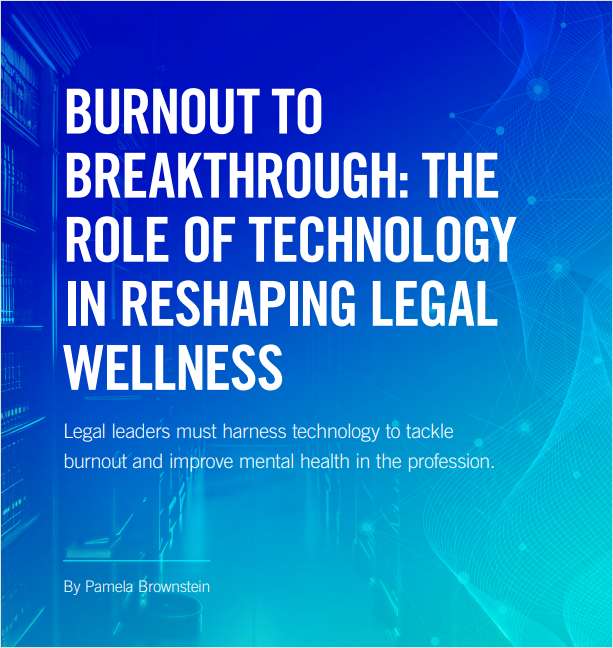The future in your hands
Contemplating an office move generates a long list of key considerations. What the considerations are will depend on who you ask. Most important for the managing partner or chief executive of a law firm may be location. Rent and moving costs will drive the financial director; ease of maintenance will spur on the facilities manager and the quality of environment will influence human resources. In all cases, this is a 15 to 25-year decision and cost will always be high on the agenda; increasingly, so will energy efficiency. It will not have escaped anyone's attention that energy saving is at the top of the political agenda. In fact, every premises is about to be assessed for its environmental performance. At a time when corporate social responsibility has never been more important, law firms must know their responsibilities and embrace opportunities that allow them to improve their performance beyond the regulatory minimum.
March 19, 2008 at 08:34 PM
6 minute read
 Contemplating an office move generates a long list of key considerations. What the considerations are will depend on who you ask. Most important for the managing partner or chief executive of a law firm may be location. Rent and moving costs will drive the financial director; ease of maintenance will spur on the facilities manager and the quality of environment will influence human resources. In all cases, this is a 15 to 25-year decision and cost will always be high on the agenda; increasingly, so will energy efficiency.
Contemplating an office move generates a long list of key considerations. What the considerations are will depend on who you ask. Most important for the managing partner or chief executive of a law firm may be location. Rent and moving costs will drive the financial director; ease of maintenance will spur on the facilities manager and the quality of environment will influence human resources. In all cases, this is a 15 to 25-year decision and cost will always be high on the agenda; increasingly, so will energy efficiency.
It will not have escaped anyone's attention that energy saving is at the top of the political agenda. In fact, every premises is about to be assessed for its environmental performance. At a time when corporate social responsibility has never been more important, law firms must know their responsibilities and embrace opportunities that allow them to improve their performance beyond the regulatory minimum.
Next month, the Energy Performance of Buildings Regulations 2007 will be introduced. These regulations transpose the energy performance certificate (EPC) requirements of the European Union (EU) Energy Performance of Buildings Directive (EPBD) into UK law.
What are EPCs?
There are three distinct types of certificate set to be introduced in the UK in response to the EU Energy Performance of Buildings Directive – EPCs for dwellings, EPCs for non-dwellings and display energy certificates (DEC) for public buildings. I will concentrate on EPCs for non-dwellings, as this is the one that impacts on the premises of law firms.
EPCs affect law firms when relocating, selling a property asset, buying a property or building new offices. In all cases, the property must display the building's energy performance in the form of an asset rating based on CO2 (in kg CO2/m2/yr) as well as a graphical representation in the form of a fridge label-style A-G rating. Each time a dwelling is put on the market an EPC, produced no more than three months before the first day of marketing, must be provided to prospective buyers or tenants. A 'recommendation report' for improving the building's energy performance must also be produced.
If this is all new to you, do not worry. Surveys have found that many UK occupiers are unaware of the EPC requirements. A CoreNet Global survey found that 60% of its members have set targets to cut energy use and 88% have already launched programmes to encourage staff to reduce their energy use. This shows that the time is right for EPCs and that companies are ready to change, so the big question is how should you respond to the new legislation.
Improving performance
What you should do, as a tenant or owner occupier, is seek to improve the efficiency of your premises. If you are a tenant, you are responsible for paying the energy bills. You have every right to put pressure on the landlord to make improvements.
Improvements to the energy performance of buildings need not incur massive costs despite popular belief. It is fairly straightforward to make initial energy savings of 10%-20% without significant investment. Saving electricity by installing sensors to operate lighting or incorporating switches on desks that turn off everything except for the CPU at night can make a massive difference.
To identify the best areas to invest, commission an energy survey. This highlights areas for improvement and establishes an environment improvement programme with corporate targets for emissions reduction. Reputable energy specialists will suggest a number of key initiatives such as:
- Logbooks to monitor the operational effectiveness of plant and equipment;
- Adjusting building management systems to improve efficiency and integrating automatic meter read;
- Setting up separate utility metering to monitor usage;
- Asking for renewable energy from your supplier; and
- Creating a benchmark for improvements and ongoing performance.
This approach is effectively energy management at a corporate level and it should also be applied to all projects that you undertake. Again, this should not incur massive costs as long as it is not an afterthought. To ensure this is not the case, a project charter should record a common vision, commitment of senior management and the objectives in the context of the refurbishment project – covering design, construction and use. When selecting contractors, ensure they adopt the team's goals and put in place a thorough implementation plan with key milestones for reviewing progress.
To save the energy, consider upgrading air conditioning systems as part of the refurbishment – far more cost-effective than standalone projects. Consider also natural ventilation and daylight/sunlight variations, water usage and different materials or products.
The installation of low and zero-carbon technologies may also be worth considering as part of major refurbishment projects N again because they are more cost effective when integrated into such works. Do not forget embodied energy such as the carbon footprint in terms of energy consumption and transport.
Make sure, no matter what work you do, that there is a good proactive and reactive maintenance programme. This will make sure the elements you have incorporated are working properly and achieving the desired efficiencies, and they will make plant and equipment last longer too.
All this advice equally applies if you own your property. You may one day want to sell it and, by then, the market for higher rated properties may be very well established. Investing now means you reap the benefits of lower energy bills now and a better sale value in the future.
A mature, energy-driven property market
If we project ourselves into the future, we will see a market where energy directly translates to rental levels and sale values with properties that achieve a higher rating being offered at a premium. Those that occupy high-performance buildings will be able to show good corporate social responsibility credentials while enjoying the savings from lower operational costs.
The future also holds the Carbon Reduction Commitment, currently a white paper, which will become legally binding in the next 12 months. This will make the environmental impact of all of a company's activities public, targets will be set for reduction and failure to meet them will lead to hefty fines or the need to buy carbon credits. Carbon trading will become universal market.
Law firms must start acting now and implementing policies and programmes that will enable them to improve beyond EPC compliance and prepare for the CRC legislation that is just around the corner.
Stuart Bowman is director of the energy and sustainability consultancy at hurleypalmerflatt and vice president of sustainability for
CoreNet Global.
This content has been archived. It is available through our partners, LexisNexis® and Bloomberg Law.
To view this content, please continue to their sites.
Not a Lexis Subscriber?
Subscribe Now
Not a Bloomberg Law Subscriber?
Subscribe Now
NOT FOR REPRINT
© 2025 ALM Global, LLC, All Rights Reserved. Request academic re-use from www.copyright.com. All other uses, submit a request to [email protected]. For more information visit Asset & Logo Licensing.
You Might Like
View All
DeepSeek and the AI Revolution: Why One Legal Tech Expert Is Hitting Pause
4 minute read
What Happens When a Lateral Partner's Guaranteed Compensation Ends?

Lawyers React To India’s 2025 Budget, Welcome Investment And Tax Reform

Russia’s Legal Sector Is Changing as Western Sanctions Take Their Toll
5 minute readTrending Stories
- 1'Shame on Us': Lawyer Hits Hard After Judge's Suicide
- 2Upholding the Integrity of the Rule of Law Amid Trump 2.0
- 3Connecticut Movers: New Laterals, Expanding Teams
- 4Eliminating Judicial Exceptions: The Promise of the Patent Eligibility Restoration Act
- 5AI in Legal: Disruptive Potential and Practical Realities
Who Got The Work
J. Brugh Lower of Gibbons has entered an appearance for industrial equipment supplier Devco Corporation in a pending trademark infringement lawsuit. The suit, accusing the defendant of selling knock-off Graco products, was filed Dec. 18 in New Jersey District Court by Rivkin Radler on behalf of Graco Inc. and Graco Minnesota. The case, assigned to U.S. District Judge Zahid N. Quraishi, is 3:24-cv-11294, Graco Inc. et al v. Devco Corporation.
Who Got The Work
Rebecca Maller-Stein and Kent A. Yalowitz of Arnold & Porter Kaye Scholer have entered their appearances for Hanaco Venture Capital and its executives, Lior Prosor and David Frankel, in a pending securities lawsuit. The action, filed on Dec. 24 in New York Southern District Court by Zell, Aron & Co. on behalf of Goldeneye Advisors, accuses the defendants of negligently and fraudulently managing the plaintiff's $1 million investment. The case, assigned to U.S. District Judge Vernon S. Broderick, is 1:24-cv-09918, Goldeneye Advisors, LLC v. Hanaco Venture Capital, Ltd. et al.
Who Got The Work
Attorneys from A&O Shearman has stepped in as defense counsel for Toronto-Dominion Bank and other defendants in a pending securities class action. The suit, filed Dec. 11 in New York Southern District Court by Bleichmar Fonti & Auld, accuses the defendants of concealing the bank's 'pervasive' deficiencies in regards to its compliance with the Bank Secrecy Act and the quality of its anti-money laundering controls. The case, assigned to U.S. District Judge Arun Subramanian, is 1:24-cv-09445, Gonzalez v. The Toronto-Dominion Bank et al.
Who Got The Work
Crown Castle International, a Pennsylvania company providing shared communications infrastructure, has turned to Luke D. Wolf of Gordon Rees Scully Mansukhani to fend off a pending breach-of-contract lawsuit. The court action, filed Nov. 25 in Michigan Eastern District Court by Hooper Hathaway PC on behalf of The Town Residences LLC, accuses Crown Castle of failing to transfer approximately $30,000 in utility payments from T-Mobile in breach of a roof-top lease and assignment agreement. The case, assigned to U.S. District Judge Susan K. Declercq, is 2:24-cv-13131, The Town Residences LLC v. T-Mobile US, Inc. et al.
Who Got The Work
Wilfred P. Coronato and Daniel M. Schwartz of McCarter & English have stepped in as defense counsel to Electrolux Home Products Inc. in a pending product liability lawsuit. The court action, filed Nov. 26 in New York Eastern District Court by Poulos Lopiccolo PC and Nagel Rice LLP on behalf of David Stern, alleges that the defendant's refrigerators’ drawers and shelving repeatedly break and fall apart within months after purchase. The case, assigned to U.S. District Judge Joan M. Azrack, is 2:24-cv-08204, Stern v. Electrolux Home Products, Inc.
Featured Firms
Law Offices of Gary Martin Hays & Associates, P.C.
(470) 294-1674
Law Offices of Mark E. Salomone
(857) 444-6468
Smith & Hassler
(713) 739-1250








